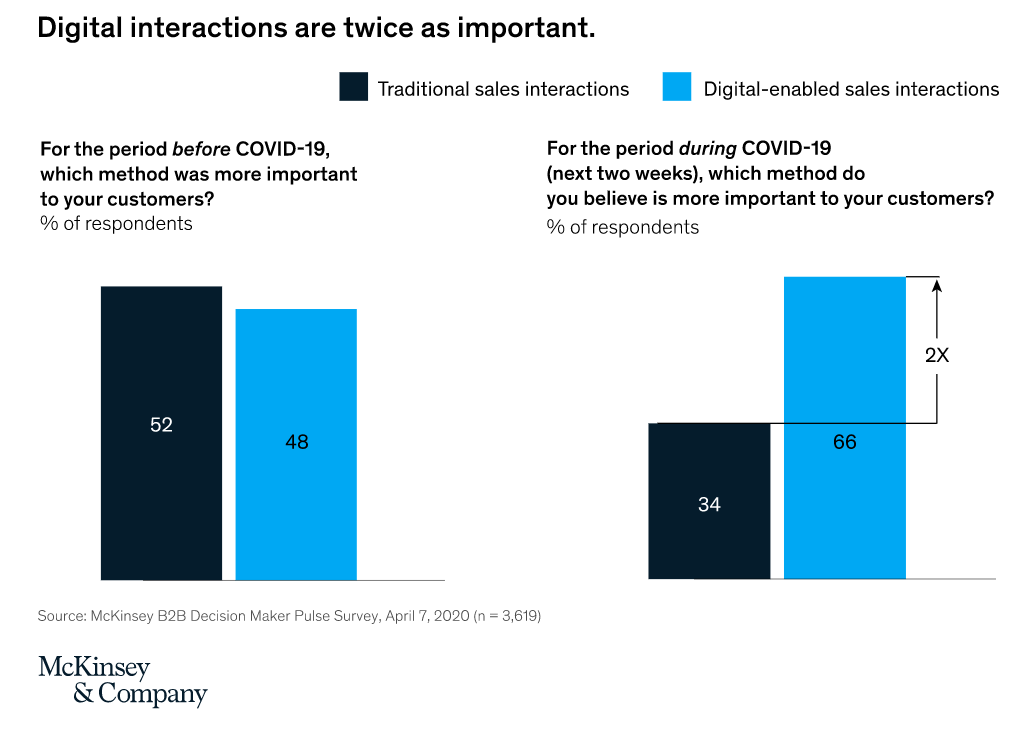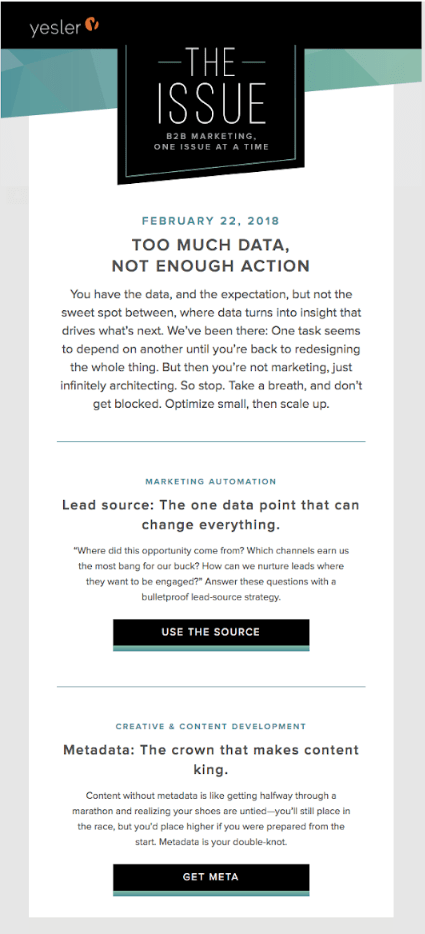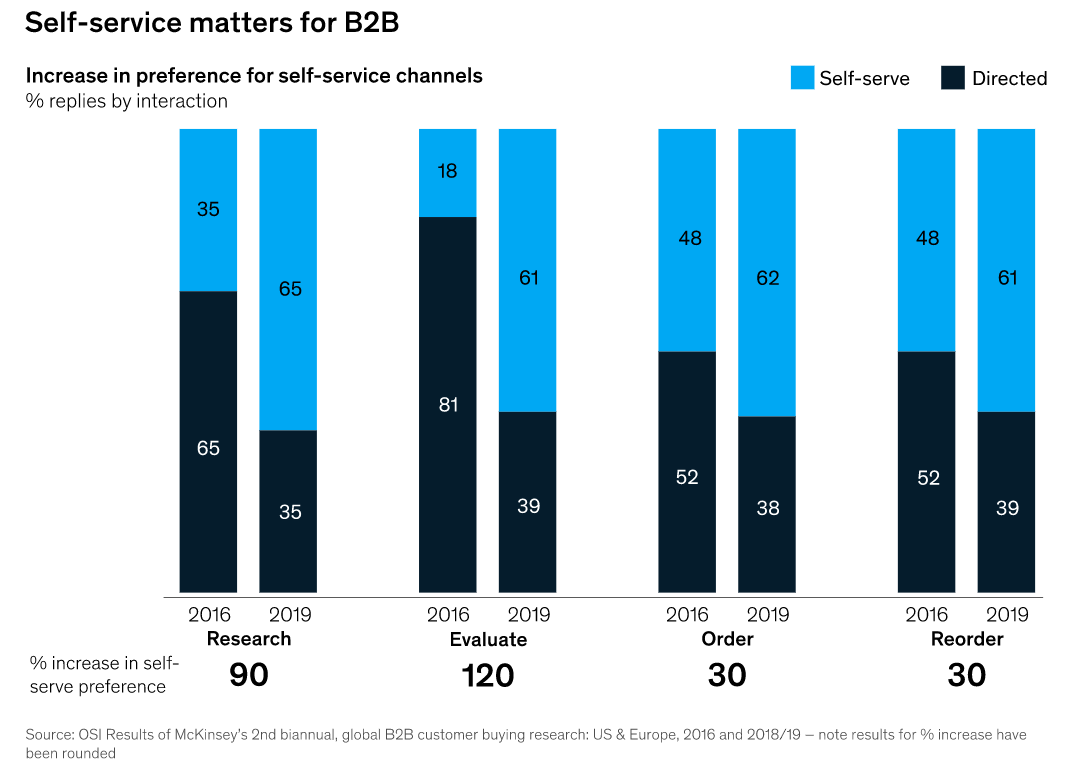 Today’s guest post was provided by Dhruv Mehta, a digital marketing professional who represents Acquire, a developer of customer engagement software.
Today’s guest post was provided by Dhruv Mehta, a digital marketing professional who represents Acquire, a developer of customer engagement software.
With varying stages of lockdown and strict social distancing norms in place, B2B marketers are taking their conversations and communications online. There’s plenty of evidence on how digital consumption has sky-rocketed over the past few months, owing to Covid-19:
- A recent survey by McKinsey states that “B2B companies see digital interactions as two to three times more important to their customers than traditional sales interactions”
- The same survey highlights the importance of selling ‘remote.’ The report claims: “Almost 90 percent of sales have moved to a videoconferencing(VC)/phone/web sales model, and while some skepticism remains, more than half believe this is equally or more effective than sales models used before COVID-19.”
- Despite the sad state of economic affairs, “53 percent of B2B companies expect to increase or maintain their spending over the next two weeks (April 8–21, 2020)”

Clearly, buyers are shying away from adapting to a new online model of sales and marketing. In that vein, let’s look at some important virtual marketing trends that have accelerated in a trying, pandemic-struck economy.
1. Start with an Evergreen Email Marketing Campaign
 The concept of email marketing is not new; however, its relevance has never been more in focus. With businesses scrambling to adapt to this new normal and following social distancing norms, email marketing has emerged as a handy tool. Here are the top benefits of using email marketing into your existing communication plan.
The concept of email marketing is not new; however, its relevance has never been more in focus. With businesses scrambling to adapt to this new normal and following social distancing norms, email marketing has emerged as a handy tool. Here are the top benefits of using email marketing into your existing communication plan.
As one example, consider Yesler’s scrollable, one-column email newsletter (that is mobile-optimized) as an excellent example.
Note how the content is neatly stacked and categorized, making for an easy and educational read! This kind of newsletter allows you to stay in touch with your existing customers and target potential leads.
Another super creative example worth looking at is Moo’s B2B email which comes loaded with animated GIFs. In a sea of sameness, Moo’s creations are sure to make heads turn and engage readers in the truest sense of the term.
Key takeaway: When developing a B2B communication plan, it makes sense to invest your efforts in email automation and create timely reminders for B2B clients so that you can retain – and gain customers organically. Email autoresponders can be scheduled to send ‘Welcome’ and ‘Thank You’ emails to subscribers, making the communication more personal and one-on-one. This helps develop deeper and more meaningful relationships with your target audience, that too, maintaining a safe social distance (which is the need of the hour).
2. Use Live Chat to Boost Your Communications Game
“33 percent of buyers surveyed rated the option of live chat during the research stage of their buying journey as one of the top three requirements for a best-in-class supplier.” – McKinsey Report
When it comes to nailing your B2B communication plan strategy, you should include the right tools that can deliver results with speed, transparency, and competency.
This is where sound live chat software can act as a game-changer. Whether it’s addressing your customer’s pain points or answering basic queries, the live chat tool acts as your platform’s ‘virtual agent.’
Say your customer is complaining about a lack of information on delivery support or is finding it difficult to make payments on your website; this is where the live chat feature can swoop in and offer instant, effective support.

3. Make Webinars a Primary B2B Communications Channel
“76% of marketers studied say webinars allow them to drive more leads, and 75% agree that webinars help them to extend their brand reach.” – On24’s 2019 Webinar Benchmark Report
Think of B2B webinars as an effective way to offer a valuable marketing monologue, share information about your product’s features, and communicate openly with your user base. In addition to this, it can offer the following benefits:
- Webinars can help establish you as an industry thought-leader: This tool allows your customers to learn from and engage with your subject matter experts. The best part? It’s all virtual and at no added costs!
- Webinars can help find quality leads: While signing up for the session, you can ask attendees to provide contact information so that you can share subsequent content, deals, and offers that may be of great interest to the customer base.
- Webinars help deepen engagement with existing leads, ensure they’re active and engaged, and finally, assist in qualifying your leads: Here’s a handy tip: When conducting a webinar, make sure to include polling questions and a QA session at the end. Historically, it has been seen that most of the webinar attendees tend to engage through chat, polls, or Q&A.
Bonus material: Look up SEMRush’s multi-track virtual event called Global Marketing Day, which amassed 50+ speakers from companies like Google, Microsoft, Lego, and Disney; and over 40,000 attendees! This event was free, and needless to say, it was a virtual hit!
4. Invest Efforts in Self-Service

“In making a purchase, buyers cited a strong preference for self-service, with suppliers’ mobile apps more than doubling in importance since 2019. This carries on a pronounced trend of preference for self-service channels across every stage of the customer decision journey.” – McKinsey Report
All things considered, potential buyers today wish to get answers by themselves and have things in their control. We live in a self-service culture today. Further data claims that “41% of customers say that self-service functionality is one of the top three ways B2B companies could make it easier for them to shop online.”
This is what Doug Root, CEO at Atlanta Light Bulbs has to say about the self-serving buyers of today:
“The modern millennial B2B buyer doesn’t want to have to pick up a phone to order. Today’s B2B buyers just want to get things done – right then and there.”
 This is why you need to integrate your Knowledge Base into your B2B communication plan and empower users to self-serve as Qumolo does in the form of a portal called ‘Qumolo Care’.
This is why you need to integrate your Knowledge Base into your B2B communication plan and empower users to self-serve as Qumolo does in the form of a portal called ‘Qumolo Care’.
The portal allows customers instant access to a wide array of self-service resources and a value-driven community that highlights best-practices and innovative ways to collaborate.
Bonus tip: Customers prefer engaging with brands on the channels of their liking, so make sure to do your research to see which platforms would best serve your ideal target audience.
5. Use Content Marketing to Your Advantage
There’s no doubt that content marketing forms the foundation for a results-oriented B2B strategy and helps marketers achieve top-of-the-funnel benefits such as increased brand awareness and outreach, greater trust and credibility, etc. In addition to this, it can also help achieve a steady stream of subscribed audiences, increased sales/revenue, and higher loyalty with existing clients/customers.

Fundamentally speaking, you can consider it as an ‘informative’ medium where you can share relevant content from different platforms to interact with a large number of users. One example of this is publishing gated content on your website such as email forms and subscription gates, in exchange for useful contact data from the user.
That said, content marketing too has its share of best-practices that need to be factored at every single juncture of your communication plan:
- Make sure that your content is wired to tell your brand’s story instead of aggressively promoting your products/services (a huge turn off for customers). In short, prioritizing your audience’s needs should take center stage instead of the promotional organizational message.
- Your content marketing drafts should constantly change based on different stages of the customer journey. Customers are better engaged if the content is relevant and fresh.
- Make sure to plug in content that includes posts by high-quality influencers as well as expert guests, in addition to highlighting user-generated content. In fact, according to CMIContent, “Top B2B performers are more likely to use non-owned channels to distribute content.”
- Make sure to measure your content marketing efforts and analyze the results to understand effectiveness.
The B2B Communication Plan Inflection Point
Needless to say, ‘social distancing’ has become a norm in our personal and professional lives. The pandemic has transformed the way B2B marketers and sellers are interacting and connecting with customers. There’s enough reason to believe that becoming ‘digital-first’ will become a key differentiator between B2B firms that are going extinct and the ones that are performing extraordinarily. What do you think?










